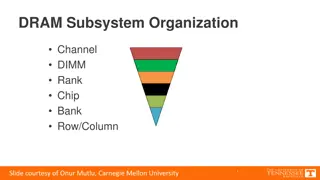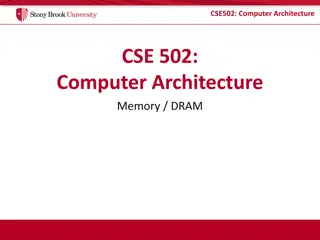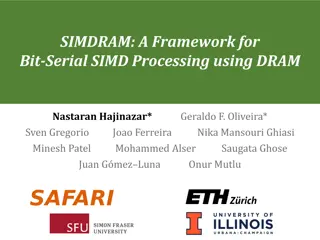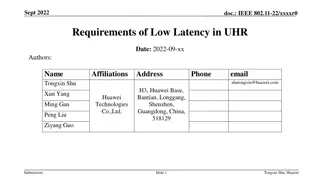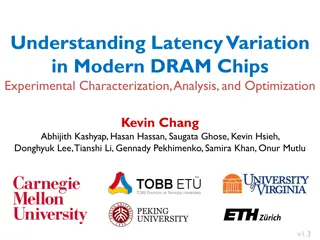CLR-DRAM: Dynamic Capacity-Latency Trade-off Architecture
CLR-DRAM introduces a low-cost DRAM architecture that enables dynamic configuration for high capacity or low latency at the granularity of a row. By allowing a single DRAM row to switch between max-capacity and high-performance modes, it reduces key timing parameters, improves system performance, and saves energy. The design addresses the limitations of existing DRAM technology, which often makes static capacity-latency trade-offs at design-time. The solution provides a more flexible and efficient approach to meeting varying memory demands in workloads and systems.
Download Presentation

Please find below an Image/Link to download the presentation.
The content on the website is provided AS IS for your information and personal use only. It may not be sold, licensed, or shared on other websites without obtaining consent from the author.If you encounter any issues during the download, it is possible that the publisher has removed the file from their server.
You are allowed to download the files provided on this website for personal or commercial use, subject to the condition that they are used lawfully. All files are the property of their respective owners.
The content on the website is provided AS IS for your information and personal use only. It may not be sold, licensed, or shared on other websites without obtaining consent from the author.
E N D
Presentation Transcript
CLR-DRAM: A Low-Cost DRAM Architecture Enabling Dynamic Capacity-Latency Trade-off Haocong Luo Taha Shahroodi Hasan Hassan Minesh Patel A. Giray Yagl k Lois Orosa Jisung Park Onur Mutlu
Executive Summary Motivation: Workloads and systems have varying memory capacity and latency demands. Problem: Commodity DRAM makes a static capacity-latency trade-off at design-time. Existing DRAM cannot adapt to varying capacity and latency demands. Goal: Design a low-cost DRAM architecture that can be dynamically configured to have high capacity or low latency at a fine granularity (i.e., at the granularity of a row). CLR-DRAM (Capacity-Latency-Reconfigurable DRAM): A single DRAM row can dynamically switch between either: Max-capacity mode with high storage density. High-performance mode with low access latency and low refresh overhead. Key Mechanism: Couple two adjacent cells and sense amplifiers to operate as a high-performance logical cell. Dynamically turn on or off this coupling at row granularity to switch between two modes. Results: Reduces key DRAM timing parameters by 35.2% to 64.2%. Improves average system performance by 18.6% and saves DRAM energy by 29.7%. 2
Talk Outline Motivation & Goal DRAM Background CLR-DRAM (Capacity-Latency-Reconfigurable DRAM) High-Performance Mode Benefits Reducing DRAM Access Latency Mitigating DRAM Refresh Overhead Evaluation SPICE Simulation System-level Evaluation Conclusion 3
Fundamental Capacity-Latency Tradeoff in DRAM Access Latency Storage Capacity DRAM 4
Motivation Motivation: Existing systems miss opportunities to improve performance by adapting to changes in main memory capacity and latency demands. The memory capacity of a system is usually overprovisioned. Many workloads underutilize the system s memory capacity. e.g., HPC [Panwar+, MICRO 19], Cloud [Chen+, ICPADS 18], and Enterprise [Di+, CLUSTER 12]. Problem: Commodity DRAM makes a static capacity-latency trade-off at design-time. Existing DRAM cannot adapt to varying capacity and latency demands. Some state-of-the-art heterogeneous DRAM architectures [Lee+, HPCA 13, Son+, ISCA 13] employ only a fixed-size and small low-latency region. Does not always provide the best possible operating point within the DRAM capacity-latency trade-off spectrum for all workloads. 5
Goal Goal: Design a low-cost DRAM architecture that can be dynamically configured to have high capacity or low latency at a fine granularity (i.e., at the granularity of a row). DRAM Row X DRAM Row X Max-capacity mode High-performance mode 6
Talk Outline Motivation & Goal DRAM Background CLR-DRAM (Capacity-Latency-Reconfigurable DRAM) High-Performance Mode Benefits Reducing DRAM Access Latency Mitigating DRAM Refresh Overhead Evaluation SPICE Simulation System-level Evaluation Conclusion 7
DRAM Background - Array Architecture SA SA SA bitline DRAM Bank wordline (row) SA SA Subarray bitline SA SA SA Open-bitline architecture 8
DRAM Background - Sense Amplifier Activated SA SA bitline DRAM Bank SA SA SA bitline Subarray SA SA Serves as the reference for the SA Not Activated 9
DRAM Background - Accessing a Cell Charge Restoration Precharge Charge Sharing bitline bitline cell Voltage VDD ? Vth ? VDD/2 ? ? VRCD 0 tRCD tRP tRAS Ready for Next ACT ACT RD/WR PRE 10
CLR-DRAM Outline Motivation & Goal DRAM Background CLR-DRAM (Capacity-Latency-Reconfigurable DRAM) High-Performance Mode Benefits Reducing DRAM Access Latency Mitigating DRAM Refresh Overhead Evaluation SPICE Simulation System-level Evaluation Conclusion 11
CLR-DRAM (Capacity-Latency-Reconfigurable DRAM) CLR-DRAM: Enables a single DRAM row to dynamically switch between max-capacity mode or high-performance mode with low cost. Key Idea: Dynamically configure the connections between DRAM cells and sense amplifiers in the density-optimized open-bitline architecture. SA1 SA1 Type 2 Type 1 bitline mode select transistors Each bitline is connected to only one SA A A B B Type 2 Type 1 SA2 SA2 Open-bitline (Baseline) CLR-DRAM 12
Max-Capacity Mode SA1 Max-capacity mode mimics the cell-to-SA connections as in the open-bitline architecture. Type 2 Type 1 Enable Type 1 transistors Disable Type 2 transistors A A B B Every single cell and its SA operate individually. Type 2 Type 1 SA2 Max-capacity mode achieves the same storage capacity as the conventional open-bitline architecture 13
High-Performance Mode SA1 SA High-performance mode couples every two adjacent DRAM cells in a row and their SAs. Type 2 Type 1 Connects to both ports of the same SA Enable Type 1 transistors Enable Type 2 transistors logical cell A A B A Two adjacent DRAM cells in a row coupled as a single logical cell. Connects to both SAs Type 2 Type 1 Two SAs of the two coupled cells coupled as a single logical SA. SA2 SA High-performance mode reduces access latency and refresh overhead via coupled cell/SA operations 14
CLR-DRAM Outline Motivation & Goal DRAM Background CLR-DRAM (Capacity-Latency-Reconfigurable DRAM) High-Performance Mode Benefits Reducing DRAM Access Latency Mitigating DRAM Refresh Overhead Evaluation SPICE Simulation System-level Evaluation Conclusion 15
High-Performance Mode Benefits: Coupled Cells bitline bitline A logical cell (two coupled cells) always stores opposite charge levels representing the same bit. SA1 SA logical cell A A B A This enables three benefits: Reducing latency of charge sharing. Early-termination of charge restoration. Retaining data for longer time. SA2 SA 16
High-Performance Mode Benefits: Coupled SAs A logical SA operates faster by having two SAs driving the same logical cell. SA1 SA SA logical cell logical SA A A B A This enables three benefits: Reducing latency of charge restoration. Reducing latency of precharge. Completing refresh in shorter time. SA2 SA SA 17
CLR-DRAM Outline Motivation & Goal DRAM Background CLR-DRAM High-Performance Mode Benefits Reducing DRAM Access Latency Mitigating DRAM Refresh Overhead Evaluation SPICE Simulation System-level Evaluation Conclusion 18
Reducing DRAM Latency: Three Ways Reducing latency of charge sharing. Early-termination of charge restoration. Reducing latency of charge restoration and precharge. High-performance mode reduces activation (tRCD), restoration (tRAS) and precharge (tRP) latencies 19
1. Reducing Charge Sharing Latency Coupled cells always store opposite charge levels representing the same bit. Drive both bitlines of a SA into opposite directions during charge sharing. Charge Sharing Charge Restoration Vth Bitline Single Cell (Baseline) VDD/2 Bitline Reduction in charge sharing latency Cell Bitline Vth Bitline Logical Cell VDD/2 Cell Cell Charge Sharing Charge Restoration 20
2. Early Termination of Charge Restoration Observation 1: Charge restoration has a long tail latency . Last 25% Charged Cell Restored ~50% Charge Restoration time Bitline VDD/2 Bitline Discharged Cell Terminating charge restoration early does not significantly degrade the charge level in the cell 21
2. Early Termination of Charge Restoration Observation 2: A discharged cell restores faster than a charged one. Charged Cell Restored Bitline Restoration latency difference VDD/2 Bitline Discharged Cell Terminating charge restoration early can still fully restore the discharged cell. Restored 22
3. Reducing Charge Restoration & Precharge Latency Logical SA contains two physical SAs. Drive the same logical cell from both ends of the bitlines. SA1 SA Faster Charge Restoration Each has a precharge unit A A B A Faster Precharge SA2 SA 23
Reducing DRAM Latency: Three Ways Reducing latency of charge sharing. Early-termination of charge restoration. Reducing latency of charge restoration and precharge. High-performance mode reduces activation (tRCD), restoration (tRAS) and precharge (tRP) latencies 24
CLR-DRAM Outline Motivation & Goal DRAM Background CLR-DRAM High-Performance Mode Benefits Reducing DRAM Access Latency Mitigating DRAM Refresh Overhead Evaluation SPICE Simulation System-level Evaluation Conclusion 25
Mitigating Refresh Overhead CLR-DRAM reduces refresh overhead of high-performance rows in two different ways: 1. Reducing Refresh Latency - Refresh is essentially activation + precharge. - All latency reductions (activation, restoration, precharge) apply to reduce each refresh operation's latency. 2. Reducing Refresh Rate - A logical cell has larger capacitance. - Tolerates more leakage. - Can be refreshed less frequently. High-performance mode reduces refresh latency (tRFC) and refresh rate (increases tREFW) 26
CLR-DRAM Outline Motivation & Goal DRAM Background CLR-DRAM High-Performance Mode Benefits Reducing DRAM Access Latency Mitigating DRAM Refresh Overhead Evaluation SPICE Simulation System-level Evaluation Conclusion 27
CLR-DRAM Outline Motivation & Goal DRAM Background CLR-DRAM High-Performance Mode Benefits Reducing DRAM Access Latency Mitigating DRAM Refresh Overhead Evaluation SPICE Simulation System-level Evaluation Conclusion 28
SPICE Simulation Methodology Model a DRAM subarray based on Rambus DRAM technology parameters [1]. Scaled to 22 nm according to the ITRS roadmap [2]. 22nm PTM-HP transistor model [3]. SPICE model will be available in July: github.com/CMU- SAFARI/clrdram [1] Rambus, DRAM Power Model (2010), http://www.rambus.com/energy [2] ITRS Roadmap, http://www.itrs2.net/itrs-reports.html [3] http://ptm.asu.edu/ 29
SPICE Simulation: Max-Capacity Mode Latencies 46.4% Max-capacity (Activation) (Restoration) (Precharge) (Write) 30 *The tRP reduction of coupling precharge units also applies to max-capacity mode.
SPICE Simulation: High-Performance Mode Latencies 64.2% 60.1% 46.4% 35.2% Max-capacity High-performance w/o early termination High-performance w/ early termination (Activation) (Restoration) (Precharge) (Write) 31 *The tRP reduction of coupling precharge units also applies to max-capacity mode.
SPICE Simulation: High-Performance Mode Latencies 64.2% 60.1% 46.4% 35.2% Max-capacity High-performance w/o early termination High-performance w/ early termination CLR-DRAM reduces DRAM latency by 35.2% to 64.2% in high-performance mode (Row Close) (Restoration) (Write) (Row Close) (Activation) (Write) (Row Open) 32 *The tRP reduction of coupling precharge units also applies to max-capacity mode.
CLR-DRAM Outline Motivation & Goal DRAM Background CLR-DRAM High-Performance Mode Benefits Reducing DRAM Access Latency Mitigating DRAM Refresh Overhead Evaluation SPICE Simulation System-level Evaluation Conclusion 33
System-Level Evaluation - Methodology Simulator: Cycle-level DRAM simulator: Ramulator [Kim+, CAL 15] Workloads: 41 single-core workloads from SPEC CPU2006, TPC, MediaBench 30 in-house synthetic random and stream access workloads 90 multi-programmed four-core workloads By randomly choosing from our real single-core workloads System Parameters: 1/4 core system with 8MB LLC 5 configurations: X% of the DRAM rows configured to high-performance mode. X = 25, 50, 75, 100. Plus a X=0 case where all rows are max-capacity mode. Map X% of the most accessed pages of workloads to high-performance mode rows. 34
CLR-DRAM Performance Fraction of High-Performance Rows Fraction of High-Performance Rows 18.6% 12.4% * Single-core Multi-core CLR-DRAM improves system performance for both single-core and multi-core workloads *GMEAN is the geometric mean of the speed up of the 41 real single-core workloads. L, M, H stand for different multi-core workload groups with different memory-intensity. 35
CLR-DRAM Energy Savings Fraction of High-Performance Rows Fraction of High-Performance Rows 19.7% 29.7% * Single-core CLR-DRAM saves DRAM energy for both single-core and multi-core workloads Multi-core *GMEAN is the geometric mean of the speed up of the 41 real single-core workloads. L, M, H stand for different multi-core workload groups with different memory-intensity. 36
Mitigating Refresh Overhead Fraction of High-Performance Rows Fraction of High-Performance Rows 66.1% 87.1% 18.6% 17.8% CLR-DRAM significantly reduces DRAM refresh energy 37
Overhead of CLR-DRAM DRAM Chip Area Overhead: 3.2% based on our conservative estimates (real overhead is likely lower). Memory Capacity Overhead: X% of the rows in high-performance mode incurs X/2% capacity overhead. [More details in the paper] CLR-DRAM is a low-cost architecture 38
Other Results, Analyses and Design Details in the Paper Sensitivity Study of Reducing Refresh Rate (increasing tREFW) The trade-off between less refresh operations (increase tREFW) and increased access latency (tRCD and tRAS). The system-level performance and DRAM refresh energy impact of the trade-off. Efficient Control of the Bitline Mode Select Transistors Only two control signals required per-bank for all its subarrays. Ensures correct SA operation in max-capacity mode. Maximizing latency-reduction in high-performance mode. Modifications to Subarray Column Access Circuitry Column (read/write) access to a high-performance row maintain full bandwidth. 39
CLR-DRAM Outline Motivation & Goal DRAM Background CLR-DRAM High-Performance Mode Benefits Reducing DRAM Access Latency Mitigating DRAM Refresh Overhead Evaluation SPICE Simulation System-level Evaluation Conclusion 40
Conclusion We introduce CLR-DRAM (Capacity-Latency-Reconfigurable DRAM) A new DRAM architecture enabling dynamic fine-grained reconfigurability between high- capacity and low-latency operation. CLR-DRAM can dynamically reconfigure every single DRAM row to operate in either Max-capacity mode: almost the same storage density as the baseline density-optimized architecture by letting each DRAM cell operate separately. High-performance mode: low access latency and low refresh overhead by coupling every two adjacent DRAM cells in the row and their sense amplifiers. Key Results Reduces four major DRAM timing parameters by 35.2-64.2%. Improves average system performance by 18.6% and saves DRAM energy by 29.7%. We hope that CLR-DRAM can be exploited to develop more flexible systems that can adapt to the diverse and changing DRAM capacity and latency demands of workloads. 41
CLR-DRAM: A Low-Cost DRAM Architecture Enabling Dynamic Capacity-Latency Trade-off Haocong Luo A. Giray Yagl k Lois Orosa Jisung Park Onur Mutlu Taha Shahroodi Hasan Hassan Minesh Patel


